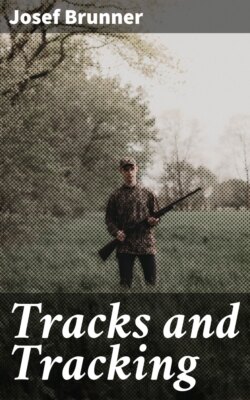Читать книгу Tracks and Tracking - Josef Brunner - Страница 5
GENERAL REMARKS
ОглавлениеAbout the Motive Features of Different Animals
TAKING it for granted that the arrangement of the individual tracks in the trail is due to the general anatomic make-up of the animal which made them, we have to consider four groups in the treatise on mammals.
The first, the members of which possess a length of body correctly proportional to their height, includes the deer, ox, bear, dog, and cat families.
The second includes rabbits, squirrels, and animals whose hind legs are very long in proportion to their front legs.
The third is made up of those animals whose legs, considering the length of their bodies, are very short—marten, mink, etc.
The fourth group embraces the animals whose legs are very short in proportion to the length of the body, and whose bodies, in addition to this, are disproportionately thick—beaver, badger, etc.
Of the various movements, we have to consider the walk, the trot, and the gallop. Animals of the first group plant the feet diagonally in the walk and trot. The hind foot track covers the one made by the forefoot of the same side. If the right forefoot touches the ground first, the left hind foot is placed next, then the left forefoot, and last the right hind foot. Thus four footfalls may be heard when hoofed animals are walking.
In the trot, which is but a hastened walk, the trail assumes more the form of a straight line, because the animal endeavors to plant the feet more under the middle of the body to obviate the swaying motion; and because of the quicker action, in which two feet touch the ground at the same moment, but two distinct footfalls can be heard.
The gallop, the quickest movement onward, is a series of leaps or jumps. In it the hind feet serve mainly as propellers while the forefeet support and brace the body; and for this reason the former are placed side by side, or nearly so, while the latter stand one behind the other in the trail. The faster the gallop, the more closely do the tracks conform to these conditions. In the greatest speed of some members of the deer family the hind feet also come nearer the center line, as shown in the illustrations. As, by the velocity of the movement, the hind feet are thrown past the point where the forefeet strike the ground, their imprints appear in front of those of the latter, a fact which should be kept constantly in mind by the trailer, since, in the case of an animal with a broken leg, the appearance of the leap imprints are usually the only means to decide which leg is broken. In animals of the first group a broken foreleg is always more serious than an injured hind leg, and therefore the game is easier brought to bag.
In members of the second group there is but one motion, no matter whether they are moving slow or fast—the hind feet are always thrown ahead of the forefeet, and the track picture is that of the leap.
As the hind feet of animals of this group are considerably larger than the forefeet, it is easily determined which individual foot has made a given track.
The animals of the third group move usually in leaps, but on account of the length of body and the shortness of the limbs, the hind feet are not placed as far ahead of the front pair as in the preceding group. At the usual gait the hind feet cover the forefeet tracks, and the trail picture therefore shows a pair of tracks side by side at regular distances. At a faster pace the trail picture changes, as shown in the illustrations; however, this is so seldom done as to be of almost no consequence to the tracker.
Members of the fourth group, like those of the first, walk and leap; however, the size of the body and the shortness of the legs combine to make a track picture entirely different from and not easily confounded with the trail of the latter. The individual tracks are close together, considering their size, and the toes of the hind feet almost invariably point inward to a marked degree, reaching an extreme limit in the beaver and the badger.
With the exception of the members of the second group and the beaver, the hind feet of all animals are smaller than the forefeet, a fact which, in some instances, has its uses when following the trail.
